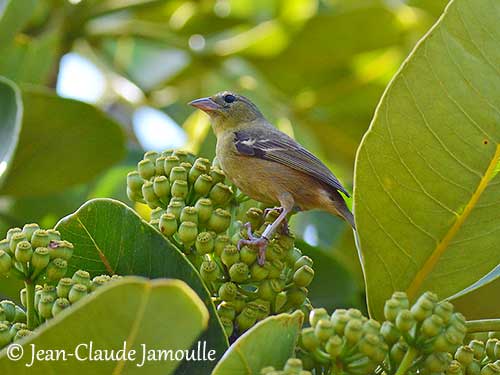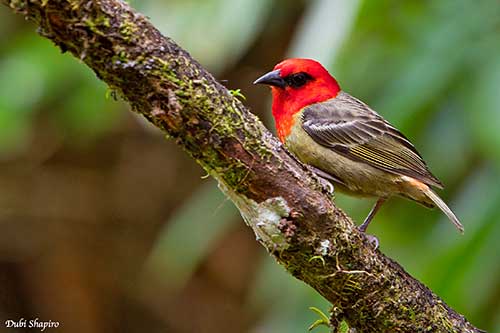
Fr: Foudi de Maurice
Ang: Mauritius Fody
All: Mauritiusweber
Esp: Fodi de Mauricio
Ita: Fody di Mauritius
Nd: Mauritiuswever
Sd: mauritiusfody
Photographers:
Jean-Claude Jamoulle
A la rencontre des Oiseaux
Dubi Shapiro
Dubi Shapiro Photo Galleries & Dubi Shapiro's Pictures on IBC
Alan & Ann Tate
AA Bird Photography
Text by Nicole Bouglouan
Sources:
HANDBOOK OF THE BIRDS OF THE WORLD Vol 15 by Josep del Hoyo-Andrew Elliot-David Christie - Lynx Edicions – ISBN: 9788496553682
The Birds of Africa: Volume VIII: The Malagasy Region: Madagascar, Seychelles, Comoros, Mascarenes - Par Roger Safford, Frank Hawkins – ISBN: 1408190494, 9781408190494- Editeur: A&C Black, 2013
Birds of Madagascar and the Indian Ocean Islands Par Roger Safford, Adrian Skerrett, Frank Hawkins – ISBN: 1472924118, 9781472924117- Editeur: Bloomsbury Publishing, 2015
The Mauritian Wildlife Foundation (MWF)
ZSL - Mauritius Fody recovery program
Weaver Watch - Mauritius Fody (Foudia rubra)
Wikipedia, the free encyclopaedia
Family Ploceidae
Page Order Passeriformes
Mauritius Fody
Foudia rubra
Passeriformes Order – Ploceidae Family
INTRODUCTION:
The Mauritius Fody is endemic to Mauritius in the Indian Ocean, where it frequents forest habitats, included degraded areas and plantations. It feeds primarily on various insect species, but berries and nectar are also part of its diet. It nests in a domed nest with side entrance and porch, placed in tree.
The Mauritius Fody is threatened by habitat loss and predation by introduced animals. Conservation efforts to control these introduced species and captive breeding program allowed the increase of the numbers, but the species is currently listed as Endangered.

DESCRIPTION OF THE BIRD:
Biometrics:
Length: 14 cm
Weight: 16-20 g
The Mauritius Fody adult male in breeding plumage has red to orange-red head, nape, chin, throat and breast. We can see a black mask around the eye, ending in a point behind the eye.
On the upperparts, mantle and back are greyish-olive and slightly streaked blackish. Lower rump and uppertail-coverts are red to orange-red. Upperwing and uppertail are dark olive-grey. Greater and median coverts show greyish fringes forming two pale wingbars.
On the underparts, belly, flanks, thighs and undertail-coverts are olive-green.
The bill is black. The eyes are dark brown. Legs and feet are brownish.
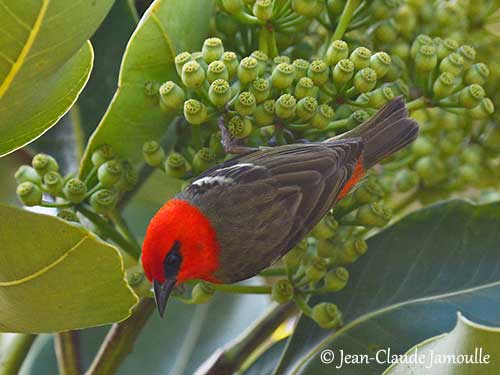
The female and the non-breeding male have dull olive-green head and upperparts, with dark streaks on the mantle. The upperwing pattern is like in breeding male.
On the face, lores and cheeks are pale olive-green and there is a pale supercilium. Throat and underparts are paler olive-green with pale yellowish tinge on chin, throat and breast.
The bill is dark brown on the upper mandible, and pale horn on the lower one.
The juvenile resembles female but it has pale brown bill during the first year.
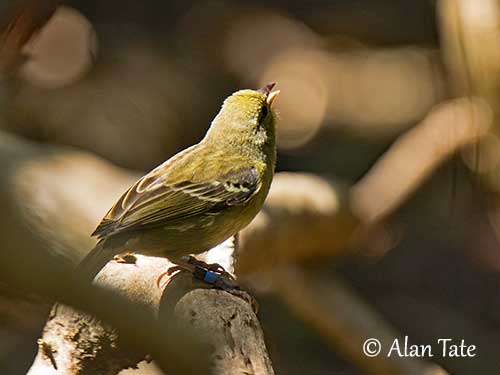
RANGE:
The Mauritius Fody is restricted to SW of Mauritius Island. A population of hand-reared birds has been introduced on Ile aux Aigrettes, a small offshore island E of Mauritius.
HABITAT:
The Mauritius Fody frequents several types of forest, included degraded woodland invaded by exotic plant species. They are numerous in small plantations surrounded by remnants of native forest.
On Ile aux Aigrettes, it frequents lowland forest and coastal scrub.
CALLS AND SONGS: SOUNDS BY XENO-CANTO
The Mauritius Fody gives a clear “plick” sometimes ending in a splutter. We can also hear a slow “chew” and a harsh buzz often repeated. A piercing squeak may follow this sound.
The song is a series of disyllabic notes “jif-jif-jif-jif-jif” usually ending in buzzing or wheezing sound.
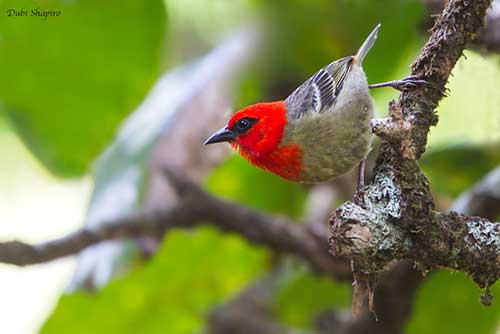
BEHAVIOUR IN THE WILD:
The Mauritius Fody feeds primarily on invertebrates, mainly insects such as grasshoppers, beetle larvae and caterpillars, and also spiders. However, it also consumes berries of introduced shrub species and endemic plants, fruits, seeds and occasionally eggs of birds and geckos. In addition, the brush-tipped tongue allows the bird to take nectar from several plant species, both native and introduced.
The Mauritius Fody forages in the vegetation, in dead leaves, and by probing bark and epiphytes.
The Mauritius Fody is monogamous with long-term pair bonds. As a resident species, the territory is permanently occupied and defended by the pair. Both mates build the nest and share most of nesting duties.
The Mauritius Fody is resident.
The flight is usually fast and direct.
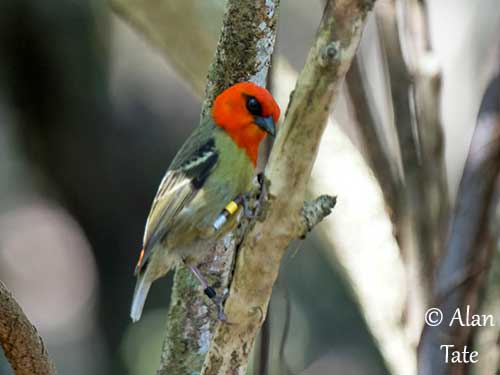
REPRODUCTION OF THIS SPECIES:
The breeding season takes place between October and February. The monogamous pair occupies and defends the territory all year round.
Both mates build a domed nest with a side entrance and often with a porch. This structure is made with grass, moss, lichens and small twigs, gathered in the surrounding, within 100 metres of the nest. The lining is added by the female and consists mainly on feathers. She adds them prior to the egg laying and up to 8 days into incubation. This strong structure is built in tree, between 2 and 9 metres above the ground, and often hidden among the foliage.
The female lays 2-3 pale blue eggs and incubates (apparently alone) during about two weeks. Both parents feed the chicks and the nestling period lasts 18 days.
The breeding success is low, mainly due to predation.
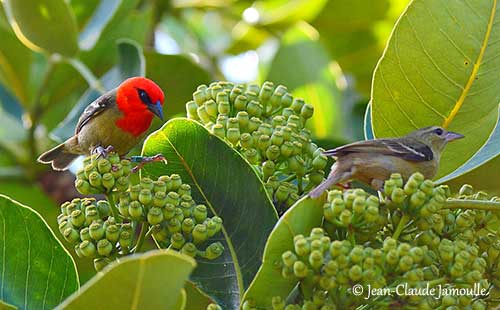
PROTECTION / THREATS / STATUS:
The Mauritius Fody was primarily affected by the clearance of the upland forest in the 1970s. But the present decline is primarily due to introduced predators such as Black rat (Rattus rattus) and monkeys (Macaca fascicularis). The degradation of native habitats by introduced mammals and plants is another important threat for this species.
Conservation efforts to control rat and monkey populations and programs to rehabilitate patches of native vegetation are in progress. A captive breeding program allowed the release 45 hand-reared chicks on Ile aux Aigrettes, an offshore islet E to Mauritius. In 2008, 140 individuals including 47 pairs were living there.
From observations, the Mauritius Fody is able to co-exist with the introduced Red Fody if suitable habitat in predator-free areas is available.
The mainland population was estimated to number 240/330 individuals in 2011-2014 (equivalent to 166/220 mature individuals). The population on Ile aux Aigrettes was estimated at 180/200 individuals in 2011-2014.
After some increase and a new decline, the population is now suspected to be stable. But currently, the Mauritius Fody is classified as Endangered.
